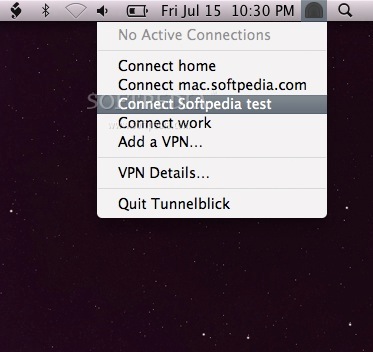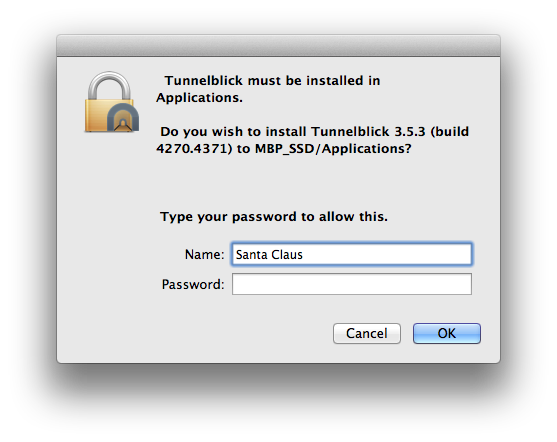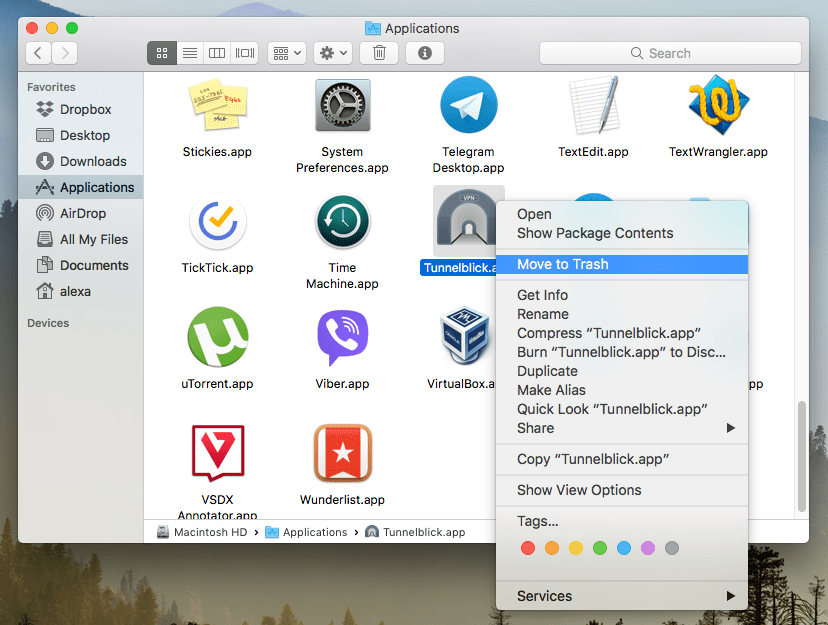
Highlighted Articles Discussion Group | To use Tunnelblick you need access to a VPN server — your computer is one end of the tunnel and the VPN server is the other end. The Tunnelblick project does not provide access to VPN servers — we are not 'VPN service providers' There are several ways to get access to a VPN server:
Employer-provided VPN ServersYour employer should supply you with an OpenVPN configuration file (.ovpn or .conf file), along with the appropriate certificate and key files, or with a Tunnelblick VPN Configuration (.tblk), which includes the certificate and key files within it. Follow the instructions from your employer or in Installing Tunnelblick to install Tunnelblick and configurations. Set Up Your Own VPN ServerThis is more complicated. It involves creating your own OpenVPN configuration file and creating your own certificate and key files for encryption. There are tutorials about setting up OpenVPN servers — try searching the Internet for 'set up openvpn server'. Tunnelblick includes 'easy-rsa' to help you with creating certificate and key files; there is an 'Open easy-rsa in Terminal' button on the Utilities panel. Instructions on using easy-rsa to create encryption files are available in the OpenVPN FAQ. If you want to set up a computer to act solely as a router/bridge/firewall, consider ZeroShell. Untangle has a free VPN component. If you have a router running DD-WRT, you can use OpenVPN on DD-RT. There is a tutorial. If you want to run an high-performance OpenVPN server 'in the cloud', see Create a Private OpenVPN Service with AWS Client VPN Endpoint [github.com]. If you want to run an OpenVPN server 'in the cloud' which also does ad blocking, take a look at the instructions at Pi-Hole and PiVPN on Google Compute Engine Free Tier with Full Tunnel and Split Tunnel OpenVPN Configurations. (Note that the instructions download and install pi-hole and piVPN by piping from curl to bash. A better practice is to download the install scripts, examine them for problems, and then run the already-examined scripts.) VPN Service ProvidersAnother way to get access to a VPN server is to use a VPN service provider, an organization that makes its VPN servers available (free or for a fee). Some provide you with a customized, and possibly renamed, version of Tunnelblick.
VPN service providers: email webmaster@tunnelblick.net to be listed on this page. Disclaimer: The products, services, and links on this page are not endorsed or recommended by the Tunnelblick project or its developers. This list is offered solely for the convenience of those wishing to use Tunnelblick. | |||||||||||||||||||||||||||||||||||||||||||||
Tunnelblick Share Vpn Mac
Highlighted Articles Discussion Group | To use Tunnelblick you need access to a VPN server — your computer is one end of the tunnel and the VPN server is the other end. The Tunnelblick project does not provide access to VPN servers — we are not 'VPN service providers' There are several ways to get access to a VPN server:
Employer-provided VPN ServersYour employer should supply you with an OpenVPN configuration file (.ovpn or .conf file), along with the appropriate certificate and key files, or with a Tunnelblick VPN Configuration (.tblk), which includes the certificate and key files within it. Follow the instructions from your employer or in Installing Tunnelblick to install Tunnelblick and configurations. Set Up Your Own VPN ServerThis is more complicated. It involves creating your own OpenVPN configuration file and creating your own certificate and key files for encryption. There are tutorials about setting up OpenVPN servers — try searching the Internet for 'set up openvpn server'. Tunnelblick includes 'easy-rsa' to help you with creating certificate and key files; there is an 'Open easy-rsa in Terminal' button on the Utilities panel. Instructions on using easy-rsa to create encryption files are available in the OpenVPN FAQ. If you want to set up a computer to act solely as a router/bridge/firewall, consider ZeroShell. Untangle has a free VPN component. If you have a router running DD-WRT, you can use OpenVPN on DD-RT. There is a tutorial. If you want to run an high-performance OpenVPN server 'in the cloud', see Create a Private OpenVPN Service with AWS Client VPN Endpoint [github.com]. If you want to run an OpenVPN server 'in the cloud' which also does ad blocking, take a look at the instructions at Pi-Hole and PiVPN on Google Compute Engine Free Tier with Full Tunnel and Split Tunnel OpenVPN Configurations. (Note that the instructions download and install pi-hole and piVPN by piping from curl to bash. A better practice is to download the install scripts, examine them for problems, and then run the already-examined scripts.) VPN Service ProvidersAnother way to get access to a VPN server is to use a VPN service provider, an organization that makes its VPN servers available (free or for a fee). Some provide you with a customized, and possibly renamed, version of Tunnelblick.
VPN service providers: email webmaster@tunnelblick.net to be listed on this page. Disclaimer: The products, services, and links on this page are not endorsed or recommended by the Tunnelblick project or its developers. This list is offered solely for the convenience of those wishing to use Tunnelblick. | |||||||||||||||||||||||||||||||||||||||||||||


Tunnelblick Vpn Mac Funktioniert Nicht

Tunnelblick Mac Vpn Free
For more information about the Tunnelblick client application for macOS, see the Tunnelblick documentation on the Tunnelblick website. To establish a VPN connection Start the Tunnelblick client application and choose I have configuration files. Tunnelblick is a free, open-source VPN interface that allows you to connect to our network via the OpenVPN protocol. Watch this video to see how to set up OpenVPN on macOS with Tunnelblick, or continue reading for detailed instructions. The Tunnelblick application is one of the alternative ways to connect to NordVPN servers on your Mac. This is a good option for those who prefer a manual connection and like tinkering with open-source software. That said, it lacks the additional features of the NordVPN native app but still uses the same VPN protocol — OpenVPN.




